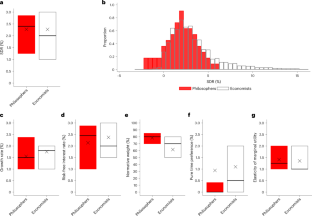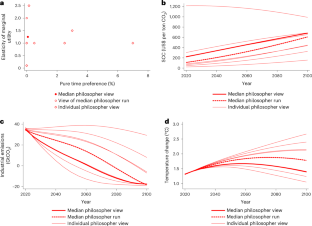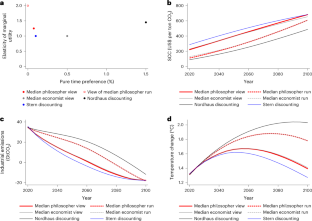Abstract
The estimated value to society from climate change mitigation is highly sensitive to the long-term social discount rate. Governmental discounting guidance has almost exclusively been influenced by economists, although it is not clear that they possess any special expertise on intergenerational ethics. Here, by contrast, we report the views of philosophers, who are the most trained in ethical matters. We show that, as a group, these experts offer strong support for a real social discount rate of 2%, a value that is also predominantly backed by economists. We find multidisciplinary support for climate policy paths in line with the United Nations climate targets when views on discounting determinants are applied within a recent update of the DICE integrated assessment model. However, this apparent agreement hides important differences in views on how the ethics of intergenerational welfare can be better incorporated into climate policy evaluation.
This is a preview of subscription content, access via your institution
Access options
Access Nature and 54 other Nature Portfolio journals
Get Nature+, our best-value online-access subscription
$29.99 / 30 days
cancel any time
Subscribe to this journal
Receive 12 print issues and online access
$209.00 per year
only $17.42 per issue
Rent or buy this article
Get just this article for as long as you need it
$39.95
Prices may be subject to local taxes which are calculated during checkout



Data availability
The data that support the plots in this paper and other findings of this study are available at the following repository: https://doi.org/10.5281/zenodo.7920803.
Code availability
All code used to produce the analysis is available at the following repository: https://doi.org/10.5281/zenodo.7920803. The details of implementation can be found in Methods.
References
-
Arrow, K. et al. Determining benefits and costs for future generations. Science 341, 349–350 (2013).
-
Weitzman, M. L. Gamma discounting. Am. Econ. Rev. 91, 260–271 (2001).
-
Aldy, J. E., Kotchen, M. J., Stavins, R. N. & Stock, J. H. Keep climate policy focused on the social cost of carbon. Science 373, 850–852 (2021).
-
Wagner, G. et al. Eight priorities for calculating the social cost of carbon. Nature 590, 548–550 (2021).
-
Standards of Performance for New, Reconstructed, and Modified Sources and Emissions Guidelines for Existing Sources: Oil and Natural Gas Sector Climate Review (US Environmental Protection Agency, 2022).
-
Groom, B. & Hepburn, C. Reflections—looking back at social discounting policy: the influence of papers, presentations, political preconditions, and personalities. Rev. Environ. Econ. Policy 11, 336–356 (2017).
-
Dasgupta, P. Discounting climate change. J. Risk Uncertain. 37, 141–169 (2008).
-
Broome, J. Efficiency and future generations. Econ. Phil. 34, 221–241 (2018).
-
Groom, B. & Maddison, D. New estimates of the elasticity of marginal utility for the UK. Environ. Resour. Econ. 72, 1155–1182 (2019).
-
Nesje, F. Cross-Dynastic Intergenerational Altruism Working Paper No. 9626 (CESifo, 2022).
-
Beard, S. The dilemma of discounting: the impossibility of setting a context independent Ramsey discount rate for human wellbeing. Rerum Causae 3, 11–21 (2011).
-
Broome, J. Discounting the future. Phil. Public Aff. 23, 128–156 (1994).
-
Caney, S. Climate change and the future: discounting for time, wealth, and risk. J. Soc. Phil. 40, 163–186 (2009).
-
Greaves, H. Discounting for public policy: a survey. Econ. Phil. 33, 391–439 (2017).
-
Heilmann, C. Values in time discounting. Sci. Eng. Ethics 23, 1333–1349 (2017).
-
Kelleher, J. P. Pure time preference in intertemporal welfare economics. Econ. Phil. 33, 441–473 (2017).
-
Medvecky, F. Valuing environmental costs and benefits in an uncertain future: risk aversion and discounting. Erasmus J. Phil. Econ. 5, 1–23 (2012).
-
Mogensen, A. L. The only ethical argument for positive δ? Partiality and pure time preference. Phil. Stud. 179, 2731–2750 (2022).
-
Parfit, D. Reasons and Persons (Oxford Univ. Press, 1984).
-
Drupp, M. A., Freeman, M. C., Groom, B. & Nesje, F. Discounting disentangled. Am. Econ. J. Econ. Policy 10, 109–134 (2018).
-
Hänsel, M. C. et al. Climate economics support for the UN climate targets. Nat. Clim. Change 10, 781–789 (2020).
-
Nordhaus, W. Projections and uncertainties about climate change in an era of minimal climate policies. Am. Econ. J. Econ. Policy 10, 333–360 (2018).
-
The Green Book (HM Treasury, 2020).
-
Cost–Benefit Analysis and the Environment: Further Developments and Policy Use (OECD, 2018).
-
Groom, B., Drupp, M. A., Freeman, M. C. & Nesje, F. The future, now: a review of social discounting. Annu. Rev. Resour. Econ. 14, 467–491 (2022).
-
Howard, P. & Schwartz, J. A. Valuing the future: legal and economic considerations for updating discount rates. Yale J. Regul. 39, 595–657 (2022).
-
Christensen, P., Gillingham, K. & Nordhaus, W. Uncertainty in forecasts of long-run economic growth. Proc. Natl Acad. Sci. USA 115, 5409–5414 (2018).
-
Rennert, K. et al. Comprehensive evidence implies a higher social cost of CO2. Nature 10, 687–692 (2022).
-
Nordhaus, W. D. A Question of Balance (Yale Univ. Press, 2008).
-
Stern, N. The Economics of Climate Change: The Stern Review (Cambridge Univ. Press, 2007).
-
Colyvan, M., Cox, D. & Steele, K. Modelling the moral dimension of decisions. Nous 44, 503–529 (2010).
-
Zuber, S. & Asheim, G. B. Justifying social discounting: the rank-discounted utilitarian approach. J. Econ. Theory 147, 1572–1601 (2012).
-
Sterner, T. & Persson, U. M. An even sterner review: introducing relative prices into the discounting debate. Rev. Environ. Econ. Policy 2, 61–76 (2008).
-
Drupp, M. A. & Hänsel, M. C. Relative prices and climate policy: how the scarcity of nonmarket goods drives policy evaluation. Am. Econ. J. Econ. Policy 13, 168–201 (2021).
-
Emmerling, J., Groom, B. & Wettingfeld, T. Discounting and the representative median agent. Econ. Lett. 161, 78–81 (2017).
-
Fleurbaey, M. & Zuber, S. Discounting, risk and inequality: a general approach. J. Public Econ. 128, 34–49 (2015).
-
Gollier, C. Pricing the Planet’s Future: The Economics of Discounting in an Uncertain World (Princeton Univ. Press, 2013).
-
Cropper, M. L., Freeman, M. C., Groom, B. & Pizer, W. A. Declining discount rates. Am. Econ. Rev. 104, 538–543 (2014).
-
Valuing Climate Damages: Updating Estimation of the Social Cost of Carbon Dioxide Tech. Rep. (National Academies of Sciences, Engineering, and Medicine, 2017).
-
Newell, R. G., Pizer, W. A. & Prest, B. C. A discounting rule for the social cost of carbon. J. Assoc. Environ. Resour. Econ. 9, 1017–1046 (2022).
-
Emmerling, J. et al. The role of the discount rate for emission pathways and negative emissions. Environ. Res. Lett. 14, 104008 (2019).
-
Pindyck, R. S. The use and misuse of models for climate policy. Rev. Environ. Econ. Policy 11, 100–114 (2017).
-
Sunstein, C. R. On not revisiting official discount rates: institutional inertia and the social cost of carbon. Am. Econ. Rev. 104, 547–551 (2014).
-
Nesje, F., Drupp, M., Freeman, C. M. & Groom, B. Replication files for ‘Philosophers and economists agree on climate policy paths but for different reasons’. Zenodo https://doi.org/10.5281/zenodo.7920803 (2023).
-
Armstrong, J. S. & Overton, T. S. Estimating nonresponse bias in mail surveys. J. Mark. Res. 14, 396–402 (1977).
-
Necker, S. Scientific misbehavior in economics. Res. Policy 43, 1747–1759 (2014).
-
Johnson, T. P. & Wislar, J. S. Response rates and nonresponse errors in surveys. JAMA 307, 1805–1806 (2012).
-
Carleton, T. & Greenstone, M. A guide to updating the US government’s social cost of carbon. Rev. Environ. Econ. Policy 16, 196–218 (2022).
Acknowledgements
We thank our many survey respondents; seminar audiences at LSE, Copenhagen, EAERE 2021 and Miljøøkonomisk konference 2021; and G. Asheim, A. Blok, J. Broome, H. Greaves, K. Mintz-Woo, K. Nyborg, P. G. Piacquadio and P. B. Sørensen for helpful comments. We also thank M. Hänsel for providing an additional run from the updated DICE model and M. Lustig for excellent research assistance. We acknowledge support from the LSE, STICERD, CREE funded by Norwegian Research Council (grant no. 209698); NATCOOP funded by the European Research Council (grant no. 678049); and the DFG under Germany’s Excellence Strategy (EXC 2037 and CLICCS) project no. 390683824, contribution to the Center for Earth System Research and Sustainability (CEN) of Universität Hamburg. B.G. is the Dragon Capital Chair of Biodiversity Economics, funded by Dragon Capital.
Author information
Authors and Affiliations
Contributions
F.N., M.A.D., M.C.F. and B.G. designed the research. F.N., M.A.D. and B.G. analysed the data. F.N., M.A.D., M.C.F. and B.G. wrote the paper.
Corresponding author
Correspondence to
Ben Groom.
Ethics declarations
Competing interests
The authors declare no competing interests.
Peer review
Peer review information
Nature Climate Change thanks Lisa Rennels and the other, anonymous, reviewer(s) for their contribution to the peer review of this work.
Additional information
Publisher’s note Springer Nature remains neutral with regard to jurisdictional claims in published maps and institutional affiliations.
Supplementary information
Supplementary Information
Supplementary Figs. 1 and 2, Table 1 and Discussion.
Rights and permissions
Springer Nature or its licensor (e.g. a society or other partner) holds exclusive rights to this article under a publishing agreement with the author(s) or other rightsholder(s); author self-archiving of the accepted manuscript version of this article is solely governed by the terms of such publishing agreement and applicable law.
About this article
Cite this article
Nesje, F., Drupp, M.A., Freeman, M.C. et al. Philosophers and economists agree on climate policy paths but for different reasons.
Nat. Clim. Chang. (2023). https://doi.org/10.1038/s41558-023-01681-w
-
Received: 05 October 2022
-
Accepted: 24 April 2023
-
Published: 25 May 2023
-
DOI: https://doi.org/10.1038/s41558-023-01681-w










